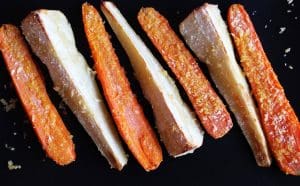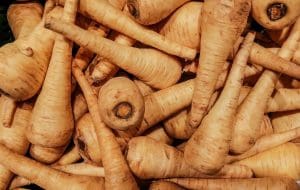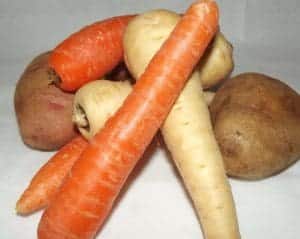Parsnips and carrots are two of the most popular root vegetables in the UK, especially during the festive season. They are both nutritious, versatile, and delicious, and can be cooked in various ways to suit different tastes and preferences.
Here the Christmas.co.uk team explore why parsnips and carrots are so popular, the history of dishing them up at Christmas, and some of the best recipes for roasting them with honey, herbs, and spices.
Why are parsnips and carrots so popular?
 Parsnips and carrots have a lot of benefits that make them appealing to many people. Here are some of the reasons why they are so popular:
Parsnips and carrots have a lot of benefits that make them appealing to many people. Here are some of the reasons why they are so popular:
They are rich in vitamins, minerals, antioxidants and fibre. This combination can help boost your immune system, lower your blood pressure, improve your digestion, and protect your eyesight. Parsnips are particularly high in vitamin C, folate (B9), and potassium, while carrots are a great source of vitamin A, beta-carotene, and biotin.
- They have a natural sweetness that can enhance the flavour of other dishes. This is especially true when roasted or glazed with honey. They also have a distinctive earthy taste that complements well with other winter vegetables, such as potatoes, Brussels sprouts and cabbage.
- They are easy to grow and store. This makes them available all year round. Parsnips and carrots can withstand cold temperatures and frost, which improves their flavour by converting their starch into sugar. They can also be stored for several months in a cool and dry place.
- They are affordable and versatile. Possibly the best reason of all as to why parsnips and carrots are so popular! You can use them in a variety of dishes, from soups and stews to salads and cakes. You can also eat them raw as a snack or add them to smoothies and juices for a healthy boost.
The history of dishing up parsnips and carrots at Christmas
Parsnips and carrots have a long history of being associated with Christmas in the UK. Apparently, parsnips were cultivated by the Romans who used them as a sweetener before sugar was widely available in Europe. They were also valued for their medicinal uses and even believed to be an aphrodisiac.
Carrots, on the other hand, were introduced to Britain by the Normans in the 11th century and were originally purple or yellow in colour before orange varieties were developed in the 16th century.
Both parsnips and carrots were considered staple foods in Europe for centuries, especially during the winter months when fresh produce was scarce. They were often boiled or mashed with butter and herbs as a simple side dish.
However, it was not until the 18th century that roasting became a popular method of cooking them, as ovens became more common in households. Roasting brought out their natural sweetness and caramelised their edges, making them more appealing and festive.
Roasted parsnips and carrots soon became a traditional accompaniment to roast goose and other meats at Christmas dinner, along with roast potatoes, stuffing, gravy, cranberry sauce and bread sauce.
Some people also like to add other ingredients to their roasted parsnips and carrots, such as honey, mustard, garlic, thyme, rosemary or nutmeg. These add extra flavour and aroma to the dish and make it more special for the occasion.
How to roast parsnips at Christmas

- Preheat your oven to 200°C/180°C fan/gas mark 6.
- Peel your parsnips and cut them into even-sized pieces. You can halve them lengthways or cut them into quarters or wedges depending on their size.
- Parboil your parsnips for about 5 minutes in a large pot of boiling water. This will help them cook faster and more evenly in the oven.
- Drain your parsnips well and toss them with some oil or melted butter in a large roasting tin. Season with salt and pepper to taste.
- Roast your parsnips for about 40 minutes or until golden and crisp on the outside and tender on the inside. Turn them halfway through for even browning.
Enjoy your roast parsnips as they are or with some gravy or sauce of your choice.
How to make honey roast parsnips
Honey roast parsnips are a sweet and sticky variation of roast parsnips that are perfect for Christmas dinner. The honey adds a lovely shine and caramelisation to the parsnips while enhancing their natural sweetness. Here is how to make honey roast parsnips:
- Follow the same steps as above for roast parsnips until step 4.
- After 20 minutes of roasting, drizzle some honey over your parsnips and toss them to coat them evenly. You can also add some mustard, garlic, or herbs for extra flavour if you like.
- Return your parsnips to the oven and roast for another 20 minutes or until glazed and golden.
Enjoy your honey roast parsnips as they are or add gravy or sauce.
oooOooo
How to make honey-glazed roast parsnips and carrots
We love this video from Waitrose which shows just how easy it is to deliver top notch honey-glazed parsnips and carrots for the festive dinner table.
Here’s the recipe the chef uses:
- Peel, trim, and cut 1kg of parsnips into long halves or quarters depending on their thickness.
- In a small bowl, whisk together 6 tbsp of olive oil, 4 tbsp of wholegrain mustard, and 6 tbsp of honey until well combined.
- Arrange the parsnips in a single layer on a large baking tray and drizzle half of the honey-mustard mixture over them. Toss to coat them evenly and season with salt and pepper to taste.
- Peel, trim, and cut 1kg of carrots into long halves or quarters depending on their thickness.
- Add the carrots to another large baking tray and drizzle the remaining honey-mustard mixture over them. Toss to coat them evenly and season with salt and pepper to taste.
- Preheat your oven to 200°C/180°C fan/gas mark 6 and roast the parsnips and carrots for about 40 minutes or until golden and tender, turning them halfway through for even browning.
- Sprinkle some thyme leaves over the roasted parsnips and carrots and serve hot or warm.
As we say, this is an effective – and easy! – way to deliver these tasty root vegetables for everyone to enjoy.
oooOoo
Cooking tips for cooking parsnips and carrots

Choose fresh and firm parsnips and carrots that are not too thin or spindly. Thin ones tend to burn easily in the oven, while thick ones take longer to cook. Aim for medium-sized ones that are about the same thickness as your thumb.
Cut your parsnips and carrots into even-sized pieces so that they cook at the same rate. Try to make them as similar as possible in shape and size, whether you prefer long batons, chunky wedges, or bite-sized pieces.
- Parboil your parsnips and carrots before roasting to speed up the cooking process and ensure they are cooked through. Parboiling also helps to remove some of the starch from the vegetables, which makes them crispier in the oven. This is really when using large pieces of carrots and parsnips – smaller pieces such as batons will cook quicker – and you’ll need to work out the timings to work with the other veg and meat you are cooking.
- Use enough oil or butter to coat your parsnips and carrots well, but not too much that they become greasy. Oil or butter helps to prevent the vegetables from sticking to the pan, adds flavour, and helps them brown nicely in the oven.
- Season your parsnips and carrots well with salt and pepper before roasting to bring out their flavour. You can also add other seasonings such as mustard, garlic, herbs, or spices to suit your taste buds.
- Drizzle honey over your parsnips and carrots halfway through roasting to give them a sweet and sticky glaze. Honey also helps to caramelise the edges of the vegetables, making them more delicious. You can use any type of honey you like, but runny honey is easier to drizzle than set honey.
- Turn your parsnips and carrots halfway through roasting to ensure they are evenly cooked and browned on all sides. Use a spatula or tongs to gently flip them over without breaking them apart.
- Check your parsnips and carrots for doneness by piercing them with a fork or knife. They should be soft on the inside but crisp on the outside. If they are not done yet, return them to the oven for a few more minutes until they are ready.
Dishing up ideas for parsnips and carrots
Once you have decided that parsnips and carrots will be your vegetables of choice for your Christmas dinner, you could consider these ideas below on how to dish them up for best effect.
- Serve them as a side dish with roast turkey, goose, chicken, beef, lamb, pork, or ham at Christmas dinner or any other special occasion. They go well with any type of gravy or sauce that you like.
- Serve them as a vegetarian main course with a cheese sauce, (see below) mushroom sauce, or vegetable gravy. You can also add some nuts, seeds, dried fruits, or cheese for extra protein and texture.
Vegetarian and vegan cheese sauce recipes for parsnips and carrots
Having mentioned dishing up carrots and parsnips as part of a vegetarian Christmas dinner, we thought it might be useful to offer a tasty cheese sauce recipe to complement the vegetables.
Recipe for vegetarian cheese sauce
Ingredients:
- 25g of butter
- 25g of plain flour
- 300ml of milk
- 150g of grated cheddar cheese
- Salt and pepper to taste.
Method:
- In a small saucepan, melt the butter over low-medium heat.
- The begin adding the flour and whisking to form a smooth paste.
- Gradually add the milk, whisking well after each addition, to create a smooth and creamy sauce.
- Bring to a boil, then lower the heat and simmer for about 10 minutes, stirring occasionally, until thickened
- Stir in the cheese and season with salt and pepper to taste.
Recipe for vegan cheese sauce
Ingredients:
- 400g of butternut squash, chopped into 2.5cm/1in pieces
- 150g cashew butter
- 1 big garlic clove, chopped finely
- Nutritional yeast, 3–4 tbsps
- Almond milk (or a vegan milk alternative), 3 tbsps
- Juice of ½ lemon
- Salt and black pepper and a sprinkle of chilli flakes to taste.
Method:
Preheat the oven to 200C/180C Fan/Gas 6.
- Place the butternut squash pieces onto a baking tray and roast for 30 minutes, or until soft
- Remove from oven and leave to cool.
- Remove butternut squash skin and place the squash into a food processor
- Add the remaining sauce ingredients
- Blend until smooth.
Enjoy your vegan cheese sauce!
oooOooo
Honey Glazed Roasted Carrots & Parsnips – The Perfect Side for Christmas Dinner!
This is a nice video from Chef Jack Ovens – with a simple, impressive recipe AND a great way to dish the veg up.
Not only does Jack say his recipe will guarantee success – but diners will be wanting more and leave with the recipe.
Interestingly, he doesn’t ‘top and tail’ the veg since he prefers to save time and puts them on a baking tray. He adds two tablespoons of olive oil, salt and pepper and gets them baking.
We did like the addition (lots of) butter to a frying pan and then adding sage leaf and a sprig of rosemary. Along with sage, he adds 60g of honey until the mixture thickens up.
He then plates everything up into a tower and pours over the butter and honey sauce.
This is a simple and really effective dish – it impressed us, so it will impress your Christmas dinner guests!
oooOooo
Parsnips & Carrots for Christmas dinner
As we have seen in this article, roasted parsnips and carrots are a delicious and festive way to enjoy these root vegetables. They are easy to make, nutritious and versatile, and can be flavoured with honey, herbs, spices, or other ingredients to suit your taste.
They are great when roasted and even better with a honey glaze and are sure to impress guests and family at Christmas dinner or any other occasion.
Try some of the recipes we have shared in this article or experiment with your own creations and enjoy the sweet and earthy taste of roasted parsnips and carrots.





